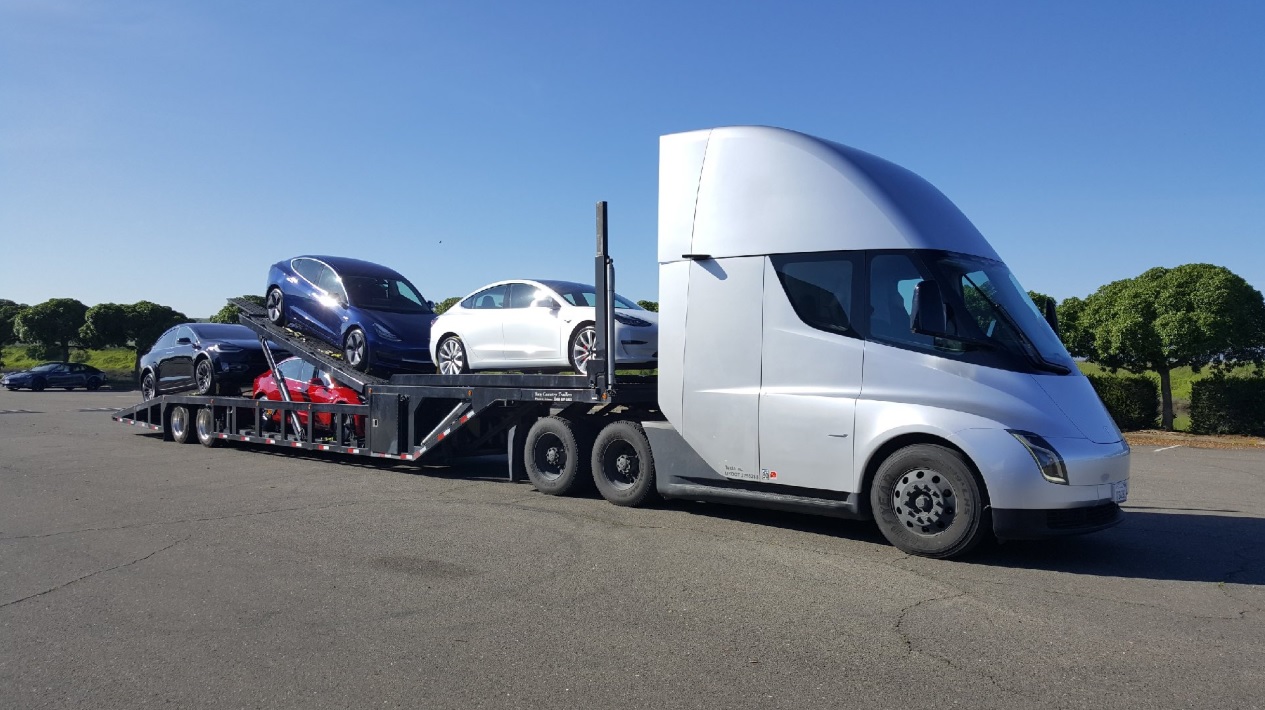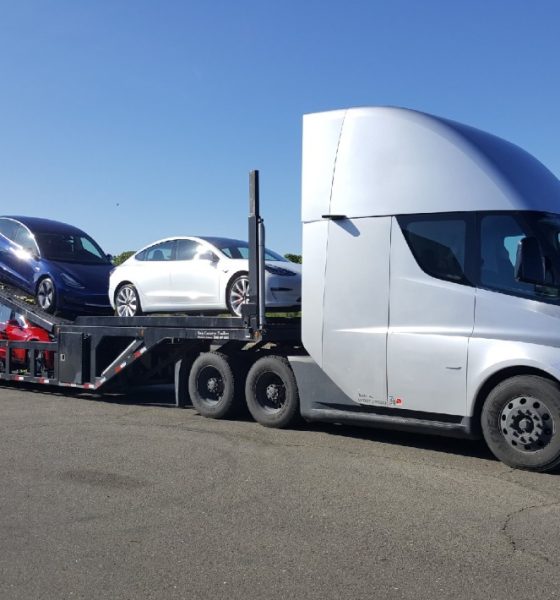

News
Tesla and EVs’ popularity pushes car carrier companies to seek higher weight limits
With the transition to electric vehicles now inevitable, car carrier companies are urging politicians and the Biden administration to raise the truck weight limitations on the United States’ highways. By doing so, car carrier companies could transport more electric vehicles. But inasmuch as the proposal seems sound, the rail sector and safety activists strongly oppose the idea, with critics arguing that heavier trucks mean more dangerous roads.
It should be noted that even before electric vehicles like the Tesla Model 3 and Model Y became mainstream, American vehicles were already getting heavier. According to the Environmental Protection Agency (EPA), the average weight of automobiles and trucks on US highways has grown from 3,200 pounds to 4,200 pounds during the last 40 years. That was far before vehicles like the Tesla Model S surged in popularity.
For now, electric vehicles comprise less than 1% of the cars on US roads, but US President Joe Biden and his administration have pushed for half of vehicle sales by 2030 to be comprised of EVs. This is great for the environment, but pushing more EVs has an aftereffect of sorts. Since electric cars are heavier than their combustion-powered counterparts due to their large batteries, car carrier companies simply cannot transport as many of them as quickly under the current weight limits for car carrier trucks on the road, according to an Autoblog report.
Sarah Amico, executive chairman of Jack Cooper, one of the largest car carrier companies in North America, outlined some risks that come if the US government’s road weight limits maintain the status quo. “The truth is we will not be able move as many electric vehicles under the current weight limit. That could mean more trucks on the road, delays in orders, and increased costs,” Amico said.
Trailers in the United States today are restricted by federal highway safety standards to 80,000 pounds gross vehicle weight. And with the growing prevalence of EVs, the car hauling industry has pushed its lobbying efforts in an attempt to update the restrictions. The effort has some supporters, such as Illinois Republican lawmaker Rodney Davis, who serves on the House Transportation Committee. Davis noted that the auto transporter industry is looking to raise the weight limit on roads by about 5-10%.
“The auto transporter industry needs a modest 5% to 10% weight variance. Otherwise, an already-challenged supply chain will require more tractor-trailer rigs on the nation’s highways to deliver the same number of finished vehicles. That means more miles driven, more wear and tear on our roads, more fuel used, and more emissions,” he said.
While an extra 8,000 pounds may not sound like much, it could be the difference maker that could allow transporters to carry the same number of EVs as their ICE-powered counterparts. The Ford F-150 Lightning is about 1,600 pounds heavier than its gas-powered sibling, for example, and the Volvo XC40 Recharge SUV weighs about 1,000 pounds more than the combustion-powered Volvo XC40.
The efforts of car carrier companies, however, have met strong opposition from critics. Among these critics are the companies’ rivals in the freight rail industry, as well as safety experts who argue that heavier trucks are more difficult to stop, easier to roll, and cause more wear and tear on roads. Cathy Chase, President of Advocates for Highway and Auto Safety, mentioned some of these reservations. “With any incremental change comes incremental danger, and that results in more fatalities,” Chase said.
But while the concerns of skeptics are reasonable, the use of all-electric trucks like the Tesla Semi should address a number of safety concerns about heavier vehicles on the road. Electric trucks, after all, utilize systems such as regenerative braking to help the vehicles stop safely. The rollout of systems like Autopilot and FSD could also be a difference-maker in the safety of trucks, as they could ensure that pedestrians and other commuters are as safe as possible on the road.
Don’t hesitate to contact us with news tips. Just send a message to simon@teslarati.com to give us a heads up.

News
Tesla FSD fleet is nearing 7 billion total miles, including 2.5 billion city miles
As can be seen on Tesla’s official FSD webpage, vehicles equipped with the system have now navigated over 6.99 billion miles.

Tesla’s Full Self-Driving (Supervised) fleet is closing in on almost 7 billion total miles driven, as per data posted by the company on its official FSD webpage.
These figures hint at the massive scale of data fueling Tesla’s rapid FSD improvements, which have been quite notable as of late.
FSD mileage milestones
As can be seen on Tesla’s official FSD webpage, vehicles equipped with the system have now navigated over 6.99 billion miles. Tesla owner and avid FSD tester Whole Mars Catalog also shared a screenshot indicating that from the nearly 7 billion miles traveled by the FSD fleet, more than 2.5 billion miles were driven inside cities.
City miles are particularly valuable for complex urban scenarios like unprotected turns, pedestrian interactions, and traffic lights. This is also the difference-maker for FSD, as only complex solutions, such as Waymo’s self-driving taxis, operate similarly on inner-city streets. And even then, incidents such as the San Francisco blackouts have proven challenging for sensor-rich vehicles like Waymos.
Tesla’s data edge
Tesla has a number of advantages in the autonomous vehicle sector, one of which is the size of its fleet and the number of vehicles training FSD on real-world roads. Tesla’s nearly 7 billion FSD miles then allow the company to roll out updates that make its vehicles behave like they are being driven by experienced drivers, even if they are operating on their own.
So notable are Tesla’s improvements to FSD that NVIDIA Director of Robotics Jim Fan, after experiencing FSD v14, noted that the system is the first AI that passes what he described as a “Physical Turing Test.”
“Despite knowing exactly how robot learning works, I still find it magical watching the steering wheel turn by itself. First it feels surreal, next it becomes routine. Then, like the smartphone, taking it away actively hurts. This is how humanity gets rewired and glued to god-like technologies,” Fan wrote in a post on X.
News
Tesla starts showing how FSD will change lives in Europe
Local officials tested the system on narrow country roads and were impressed by FSD’s smooth, human-like driving, with some calling the service a game-changer for everyday life in areas that are far from urban centers.

Tesla has launched Europe’s first public shuttle service using Full Self-Driving (Supervised) in the rural Eifelkreis Bitburg-Prüm region of Germany, demonstrating how the technology can restore independence and mobility for people who struggle with limited transport options.
Local officials tested the system on narrow country roads and were impressed by FSD’s smooth, human-like driving, with some calling the service a game-changer for everyday life in areas that are far from urban centers.
Officials see real impact on rural residents
Arzfeld Mayor Johannes Kuhl and District Administrator Andreas Kruppert personally tested the Tesla shuttle service. This allowed them to see just how well FSD navigated winding lanes and rural roads confidently. Kruppert said, “Autonomous driving sounds like science fiction to many, but we simply see here that it works totally well in rural regions too.” Kuhl, for his part, also noted that FSD “feels like a very experienced driver.”
The pilot complements the area’s “Citizen Bus” program, which provides on-demand rides for elderly residents who can no longer drive themselves. Tesla Europe shared a video of a demonstration of the service, highlighting how FSD gives people their freedom back, even in places where public transport is not as prevalent.
What the Ministry for Economic Affairs and Transport says
Rhineland-Palatinate’s Minister Daniela Schmitt supported the project, praising the collaboration that made this “first of its kind in Europe” possible. As per the ministry, the rural rollout for the service shows FSD’s potential beyond major cities, and it delivers tangible benefits like grocery runs, doctor visits, and social connections for isolated residents.
“Reliable and flexible mobility is especially vital in rural areas. With the launch of a shuttle service using self-driving vehicles (FSD supervised) by Tesla in the Eifelkreis Bitburg-Prüm, an innovative pilot project is now getting underway that complements local community bus services. It is the first project of its kind in Europe.
“The result is a real gain for rural mobility: greater accessibility, more flexibility and tangible benefits for everyday life. A strong signal for innovation, cooperation and future-oriented mobility beyond urban centers,” the ministry wrote in a LinkedIn post.
News
Tesla China quietly posts Robotaxi-related job listing
Tesla China is currently seeking a Low Voltage Electrical Engineer to work on circuit board design for the company’s autonomous vehicles.

Tesla has posted a new job listing in Shanghai explicitly tied to its Robotaxi program, fueling speculation that the company is preparing to launch its dedicated autonomous ride-hailing service in China.
As noted in the listing, Tesla China is currently seeking a Low Voltage Electrical Engineer to work on circuit board design for the company’s autonomous vehicles.
Robotaxi-specific role
The listing, which was shared on social media platform X by industry watcher @tslaming, suggested that Tesla China is looking to fill the role urgently. The job listing itself specifically mentions that the person hired for the role will be working on the Low Voltage Hardware team, which would design the circuit boards that would serve as the nervous system of the Robotaxi.
Key tasks for the role, as indicated in the job listing, include collaboration with PCB layout, firmware, mechanical, program management, and validation teams, among other responsibilities. The role is based in Shanghai.
China Robotaxi launch
China represents a massive potential market for robotaxis, with its dense urban centers and supportive policies in select cities. Tesla has limited permission to roll out FSD in the country, though despite this, its vehicles have been hailed as among the best in the market when it comes to autonomous features. So far, at least, it appears that China supports Tesla’s FSD and Robotaxi rollout.
This was hinted at in November, when Tesla brought the Cybercab to the 8th China International Import Expo (CIIE) in Shanghai, marking the first time that the autonomous two-seater was brought to the Asia-Pacific region. The vehicle, despite not having a release date in China, received a significant amount of interest among the event’s attendees.








